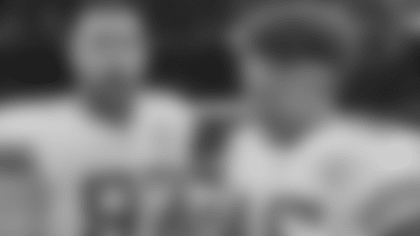
On Monday, I broke down the offense's performance in the win over the Jets, so let's take a long look here at the defense and how they performed against New York. This game was all about trying to defend a tough matchup on the outside in Brandon Marshall, but the bigger question was how several backup players would execute their roles with starters out of the lineup? Cedric Thornton, Taylor Hart, Mychal Kendricks and Kiko Alonso were all out of Sunday's matchup. During the game, the defense lost Chris Maragos as well, forcing other players into the lineup.
Up front, Brandon Bair was called upon to start. Bair was inactive for the first two weeks, but with plenty of experience as a backup, we knew what he'd bring to the table. Long, strong and stout at the point of attack, Bair isn't the most dynamic pass rusher, but he is a great two-gapper at the defensive end spot and his long arms allow him to disrupt passing lanes, something he did early and often against the Jets.
Bair stands up Jets center Nick Mangold and executes what Chip Kelly refers to as "Strike, see, throw and go." That means Bair comes off the ball, initiates contact with the blocker, gets his eyes up to the ball carrier, makes his read on where the ball is going, throws the blocker to the side and attacks the ball. Bair executes that technique perfectly for the stop early in the game.
Bair had three pass deflections on Sunday, and it's one of the reasons Kelly loves length up front on the defensive line. You want to be able to keep offensive linemen away from you in the run game, but in the pass game the ability to affect the quarterback either by causing interference in the throwing lane or by attacking his throwing arm are all traits that come with that body type.
Bair's ability to interrupt passing lanes came in handy in the fourth quarter when the Eagles needed it most. He was able to deflect this Ryan Fitzpatrick pass, knocking the ball up into the waiting arms of rookie linebacker Jordan Hicks for his first career interception. Hicks made a huge impact in his first NFL start, that's certainly not to my surprise. My affinity for the first-year player from Texas has never been a secret, and so far he's lived up to the expectations that the coaching staff has had for him since drafting him in the third round. After knocking Tony Romo out of the game against the Cowboys, Hicks followed it up with another outstanding performance where he led the team in tackles. However, it was the little things that Hicks did that really impressed me when I watched the tape on Monday morning.
Much like Bair, you can see Hicks attack Fitzpatrick's throwing arm, deterring a throw and forcing a desperation toss to the back, as the Eagles make a tackle for no gain. Hicks accomplished some of the smaller examples of technique well, but his natural instincts also were apparent in the win over New York, especially in the screen game.
Hicks was initially called to blitz on this play, but he recognizes the screen play early, hunts down the back, reverses field and outleverages the receiver to force him back inside toward his help. This was a really heads-up play by the rookie, who has the range and smarts to be a great player for a long time.
The Eagles in general seemed to have a really good feel for the Jets' screen game on Sunday afternoon, as they shut down pretty much all of the quick-hitting pass plays that New York had in its playbook. Much to the chagrin of the fans in attendance, the Jets kept going back to those plays, often with similar results.

On this play, the Eagles are in Cover 1 with a single-high safety, man coverage on five receivers underneath, and a five-man pressure coming in the form of another Cross Dog blitz. Outside linebacker Brandon Graham is responsible for the running back in coverage.
At the snap of the ball, look how patient and aware Graham is. He doesn't get out of control, stays balanced and is able to make a one-on-one tackle in space for a loss. This was one of many instinctive plays by the Eagles' front seven on Sunday afternoon. Another position group that I thought was particularly impressive against the Jets was the secondary. I might say it was the best the group has looked since Chip Kelly has arrived as Eagles head coach. I thought Byron Maxwell had a strong game and Nolan Carroll certainly had his best game as an Eagle.
Let's first look at this pass breakup from Carroll, who played this ball about as well as you can ask from a corner in his position. Against a receiver who has great vertical ability in Devin Smith, Carroll was textbook perfect in his technique to get from "out of phase" back to "in phase" with the receiver down the field to make a play on the ball.
So what do those terms mean? Let me break it down for you. When a receiver has a defender beat, the corner is "out of phase." At this point, it's the job of the corner to work to get back "in phase." You're trying to catch up to the receiver. You're not worried about the ball. When you see a defender who is out of phase try to turn and find the ball, that's when you see corners get beaten badly over the top because it's impossible to try to keep track of the receiver and find the football (unless the quarterback just happens to underthrow the pass).

On this play, Carroll is not looking for the ball, but executing his "out of phase" technique. If the corner isn't looking for the ball, what is he looking for? As Jaylen Watkins broke down for us on the Eagle Eye in the Sky podcast over the summer, an out-of-phase corner is looking at the receiver's hands and waiting for him to slow down for the ball. If the receiver shows his hands, you know the ball is coming. Cornerbacks will try to shoot their hands through the catch point at the last moment. But if a receiver slows down, that cornerback is now going to be back "in phase" quicker than he thought. If he doesn't turn to find the ball, he will be called for face guarding and a flag will be thrown. This is what makes the cornerback position so hard to play. It's also why traits such as top-end speed and ball skills are such important aspects of playing the position.
On this play, Carroll started out of phase, but was able to work back to in phase, which means he's in a position to play the ball in the air. The cornerback is even or slightly on top of the receiver and is able to have his off hand on that receiver with his head turned to look for the football. This corner is under control, he's in position to play the football and he will almost never get called for a penalty when he's in this position.
Carroll has his eyes on the receiver and works to get back in phase. When he sees Smith turn his head to find the ball, Carroll also turns and is able to break up the pass and get the football on the ground. This is a great play by Carroll, who also had a great pass breakup against Brandon Marshall in the middle of the field where he did a great job playing the ball and not the body. He wasn't the only one to make great plays on the ball from the "in phase" position on Sunday though.
Check out rookie cornerback Eric Rowe and his ability to get in phase to get the ball on the ground. I mentioned the speed and ball skills, but this is where a cornerback like Rowe can use his length to his advantage as well. With his long arms, he doesn't have to get as tight as a shorter corner typically would to get a feel for the receiver he's defending. His long arms also give him a longer reach to get to the catch point and knock the ball down. It would be one thing if he just made that pass breakup, but he followed that up with another great play later in the game.
On this shot, Rowe did the same thing as Carroll did earlier in the game, as he works from out of phase back to in phase, turns late and finds the ball in the air to reel in the interception. In talking with NFL Network draft analyst Mike Mayock leading up to the preseason broadcasts, we put together a breakdown segment on Rowe centered on his concerns with Rowe's ball skills at the college level, a legitimate concern for a player with just one interception in every season he played at Utah. What a fantastic play by the young rookie in his first defensive action of the regular season.
The other part of the secondary that I thought was really interesting on Sunday was, from a schematic standpoint, some of the things the Eagles did in terms of coverage. The Eagles have always shown the propensity to play some Cover 3, but they rolled out a variation of it that I have rarely seen on Sunday against the Jets.

This is what "basic" Cover 3 looks like, or what some coaches may call "Cover 3 Buzz." You've got three high defenders in the form of two cornerbacks on the outside and a safety in the middle of the field, paired with four underneath defenders. The reason it's called "Buzz" is because of the linebackers ("backers") serving as the force players in the run defense. This means that they are on the outside of the underneath coverage. This is the most basic and common form of Cover 3 used at any level.

This is the coverage the Eagles played a good amount of the time on Sunday. Notice the changes in the blue-colored zones at the bottom. Instead of the high defender at the bottom of the screen being a cornerback, it's a safety. And the underneath defender to the outside is now a cornerback. This is what's commonly referred to as "Cover 3 Cloud." With the cornerback (emphasis on the "C") serving as the force players in "Cloud" coverage, you get a few different advantages. First off, you get an aggressive jam at the line of scrimmage from the cornerback to that side, because he has a safety directly over top of him.
The pairing of a press corner with safety help over the top makes this coverage particularly effective against big physical receivers or tight ends who are flexed out wide because now they're getting disrupted at the line of scrimmage. It also is helpful against speed receivers because you have that immediate safety help over the top. It's a strong zone coverage concept also, because it messes with the quarterback. If the quarterback is reading the safeties at the snap of the ball, and he sees one of those safeties immediately run to the sideline, he may think that the middle of the field is open. This could cause him to throw a pass deep between the hashes, into the waiting arms of the middlefield safety.
This coverage, while rarer than Cover 3 Buzz, is effective because you get that disruption to one side of the field, you have immediate safety help over the top and you get to mess with the quarterback's initial read on a play. But beware, this is also a coverage that teams will try to run against because you have a cornerback responsible as the force defender outside in the run game. Fortunately, the Eagles have two big, physical corners in Maxwell and Carroll who are more than serviceable in the run game.
On this play, Carroll steps up and makes a play in the flat to stop the Jets' running back short of a first down. This was the coverage the Eagles were in for their final turnover of the day, the interception by Walter Thurmond to seal the victory.
You can see the Cover 3 Cloud coverage at the top of the screen, with Carroll pressing at the line of scrimmage. The Jets are running a Flat-7 combination, putting Carroll in a bind. He has to defend both the corner route by Marshall and the short route underneath. Carroll does a great job not biting on the short route, and sitting on the corner route just long enough to cloud the picture for Fitzpatrick. The rush up front further causes the throw to be a bit delayed. It's a bit off the mark, goes through Brandon Marshall's hands and Thurmond is there (as the high defender on the outside) to make the interception. This was a great combination of both concept and execution from Bill Davis' defense.
Fran Duffy is the producer of "Eagles Game Plan" which can be seen on Saturdays during the season. Be sure to also check out the "Eagle Eye In The Sky" podcast on the Philadelphia Eagles podcast channel on iTunes. Prior to joining the Eagles in 2011, Duffy was the head video coordinator for the Temple University Football team under former head coach Al Golden. In that role, he spent thousands of hours shooting, logging and assisting with the breakdown of the All-22 film from the team's games, practices and opponents.























